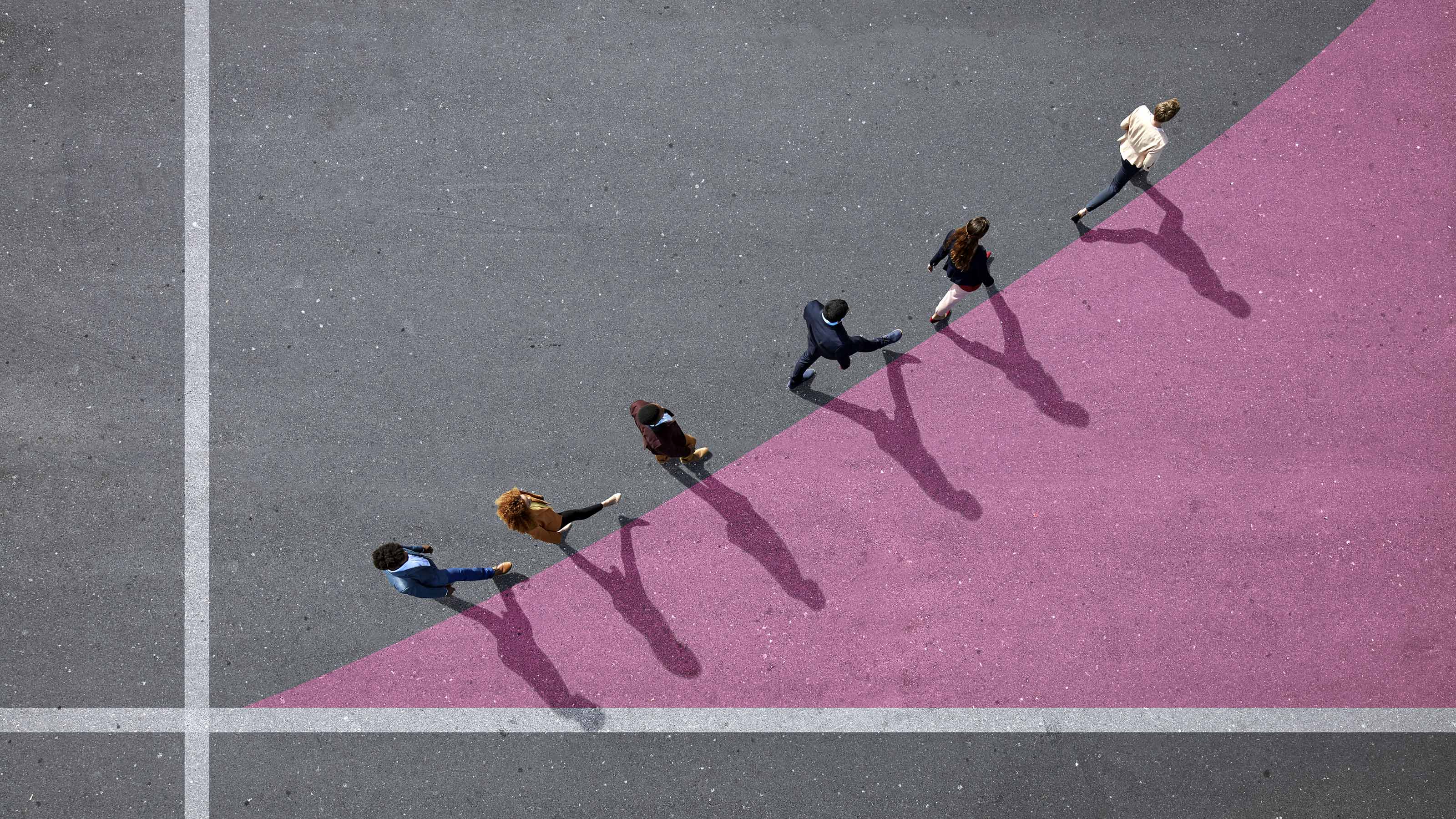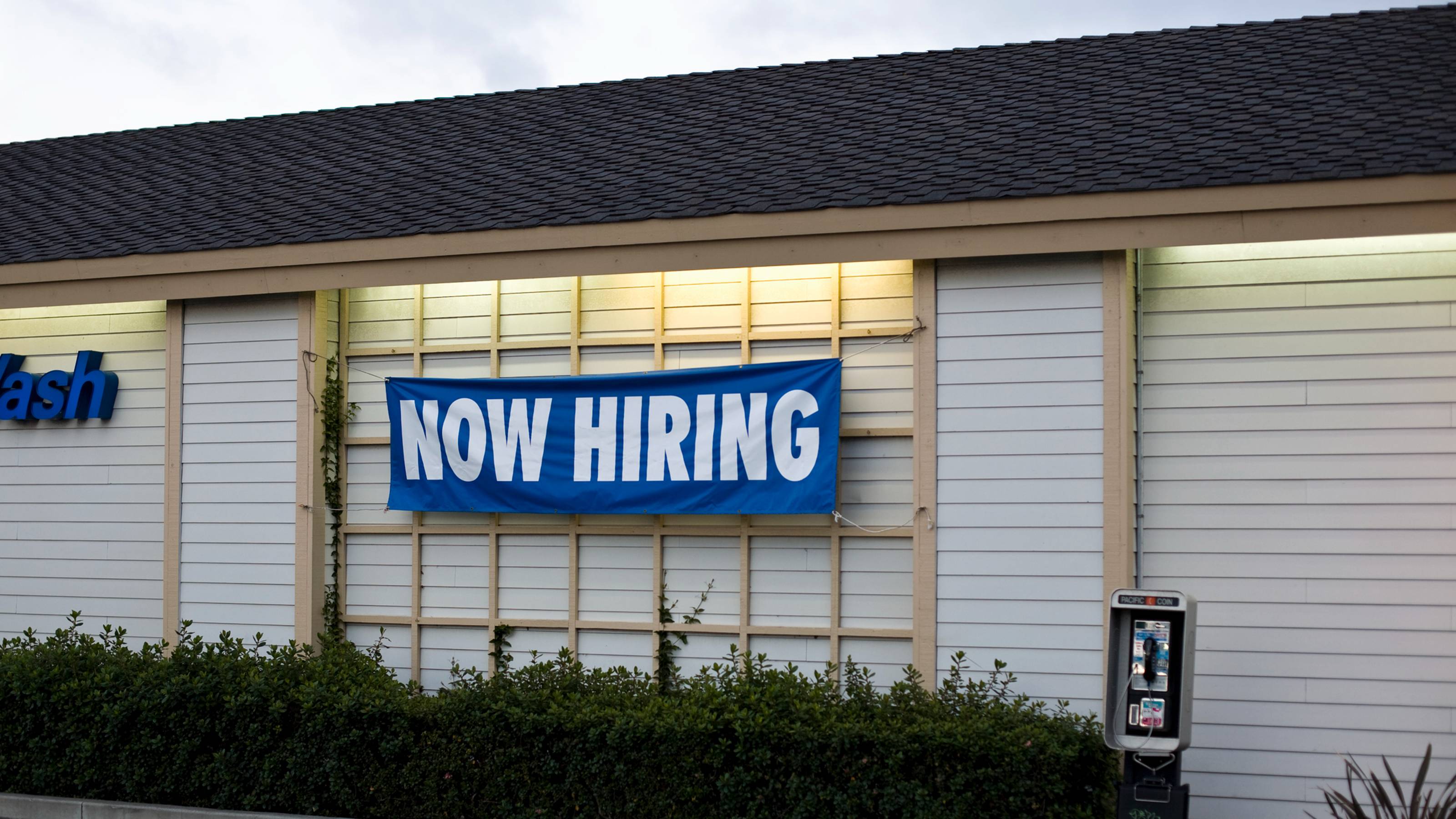August Jobs Report Shows Pace of Hiring Continues to Ease: What the Experts Are Saying
A third straight month of slower jobs growth and an uptick in the unemployment rate keeps the Fed on track to leave interest rates unchanged.


The August jobs report exceeded economists' expectations but a third straight month of more modest hiring and an uptick in the unemployment rate should keep the Federal Reserve on track to leave interest rates unchanged at the next Fed meeting, experts say.
Nonfarm payrolls expanded by 187,000 last month, the Bureau of Labor Statistics said Friday, topping economists' forecast for the creation of 170,000 jobs. Adding to the evidence of an economy that's cooling, payroll figures for June and July were revised lower by a combined 110,000 jobs. August represented the third consecutive month in which payrolls grew by less than 200,000. Note that over the past year the economy has added an average of 271,000 jobs per month.
The unemployment rate, which is derived from a separate survey, rose to 3.8%. Economists expected the unemployment rate to hold steady at July's figure of 3.5%.
From just $107.88 $24.99 for Kiplinger Personal Finance
Become a smarter, better informed investor. Subscribe from just $107.88 $24.99, plus get up to 4 Special Issues

Sign up for Kiplinger’s Free Newsletters
Profit and prosper with the best of expert advice on investing, taxes, retirement, personal finance and more - straight to your e-mail.
Profit and prosper with the best of expert advice - straight to your e-mail.
The August nonfarm payrolls report is typically difficult to decipher as many would-be respondents to government surveys are on vacation. The Hollywood actors and writers strike and the bankruptcy of trucker Yellow also added wrinkles to the data.
Nevertheless, the August jobs report suggests that the Fed's efforts to combat inflation by cooling a squeaky-tight labor market via an aggressive campaign of interest rate hikes is having an effect. Even upward wage pressure – a nagging issue for the Fed – moderated in August, rising 0.2% last month. For context, average hourly earnings rose a much hotter 0.4% in both July and June, respectively.
Experts tend to agree that the August jobs report is good news for the Fed. The central bank's rate-setting group, the Federal Open Market Committee (FOMC), is forecast to leave interest rates unchanged when it meets later this month.
The FOMC raised the short-term federal funds rate by a quarter of a percentage point to a target range of 5.25% to 5.50% when it last met in July. The hike followed a pause in interest rate hikes at the Fed's prior meeting. Interest rate traders currently assign a 93% probability to the Fed leaving interest rates unchanged at the next policy meeting.
With the August jobs report now a matter of record, we turned to economists, strategists and other experts for their thoughts on what the data means for markets, macroeconomics and monetary policy going forward. Please see a selection of their commentary, sometimes edited for brevity or clarity, below.
Jobs report: the experts weigh in

"Nonfarm payrolls rose 187,000 in August and were revised 110,000 lower over the prior months. However, Hollywood worker strikes and the Yellow trucking bankruptcy weighed on the August pace by roughly 50,000, suggesting a strong underlying pace of job gains. The household survey was strong. While the unemployment rate increased to 3.8%, this reflected a 222,000 increase in household employment offset by a 736,000 increase in the labor force – the latter reflecting increases among youths, women aged 55+, and immigrants. This continued rebalancing of the labor market is consistent with our view that the July hike in the Fed funds rate was the last of the cycle. We continue to expect unchanged policy at both the September and November FOMC meetings." – Jan Hatzius, chief economist at Goldman Sachs
"Easy does it. The job market is not exerting any pressure on the Fed to tighten further. And that is what 'we' want." – Jennifer Lee, senior economist at BMO Capital Markets
"Today's payroll report shows that the labor market is normalizing. Yes, the unemployment rate rose to 3.8%, but it was because more people came into the labor force to look for jobs – 736,000 more people came into the labor force to actively look for jobs. Overall, this report tells you that the economy is growing and normalizing. Employment growth is more than enough to keep up with population growth, worker hours are rising, and wage growth is easing. And the big picture is that there's no recession right, nor are we close to one right now barring unforeseen shocks." – Sonu Varghese, global macro strategist at Carson Group
"The July employment report will be music to the Fed's ears. Hiring trends were a bit better than expected, unemployment was a little softer than expected, and perhaps most importantly, wage gains did not accelerate at an alarming rate. The Fed, therefore, will not raise interest rates in September and will proceed with caution through the remainder of the year, carefully assessing further increases in unemployment, but unlikely to lower rates in the near-term as economic growth remains above trend and wages are still advancing faster than pre-pandemic rates. We continue to see a pause, not a pivot, and advise being Neutral to Risk, emphasizing quality, and staying fully diversified." – George Mateyo, chief investment officer at Key Private Bank
"The August jobs report offered the latest piece of evidence that the Fed's 'soft landing' prospects remain alive. Nonfarm payrolls rose a respectable 187,000, while the labor market loosened in all the right ways. The unemployment rate rose to 3.8% – the highest since the Fed began tightening policy in March of 2022 due to a swell of workers entering the labor force. The labor force participation rate rose to a fresh cycle high of 62.8% and overwhelmed another increase (+222,000) in the household measure of employment. Average hourly earnings growth also eased slightly, with wages up 0.2% in August and 4.3% over the past year. With the labor market more clearly moving back into balance, further Fed rate hikes seem unlikely in our view. However, with the labor market still tight and wage growth elevated, we expect rate cuts to remain a ways off." – Sarah House, senior economist at Wells Fargo Economics
"The U.S. labor market remains stable. The increase in the participation rate is a welcome sign. The month-over-month decline in average hourly earnings is an indication that the Fed's battle to bring inflation back to its target range is working. This mixed report will likely give the Fed enough comfort to pause rate increases at its meeting later this month. The Fed will continue to steadfastly watch labor and inflation reports to see if they need to increase rates later this year and we continue to advise our clients on ways to mitigate their risk." – Eric Merlis, managing director, co-head of global markets at Citizens
"The big takeaway from today's number is that people are back in the labor force and looking for jobs. Coronavirus distortions continue to fade. That's visible from the jump in unemployment and participation. Other items like hourly wages and negative revisions show softening and argue for a Fed to pause. Investors now have more reason to think August's surge in Treasury yields was an echo of 2022 and the last gasp of something old instead of the start of something new. Continued easing in yields could help feed the Goldilocks narrative and comparisons to the 1994-1995 soft landing." – David Russell, vice president of market intelligence at TradeStation
"People have a lot of choice and mobility within the market. Employees will stay in the driver's seat as long the delta between open jobs and available candidates remains this large. So far, businesses are showing a lot of patience and seem to have a higher tolerance to let shifts go unfilled. This is not a strategy that any CEO can employ forever though. Businesses are starting to compete to hire again, which will heat up even more as we get closer to the holiday shopping season." – Chris Todd, CEO at UKG
"Overall, the report fits in with a soft-landing scenario of an economy slowing – but not too fast as to create recessionary concerns – but slowing enough to ease inflation and, most importantly, support the thesis of a pause/no increase in rates in September to allow the Fed to further watch the trends in economic data." – Stephen Kolano, managing director, investments at Integrated Partners
"The report this morning was probably a good nonfarm payroll for the Fed. Unemployment is above expectations on participation above expectations, wage growth is below expectations, headline payrolls above expectations but last month revised down. Data shows the better balance between demand and supply the Fed is looking for...importantly keeping wage pressure contained. However, this will likely not change the view that one more hike in November is still likely in the cards. August is only one data point and the Fed looks at the whole data picture." – John Luke Tyner, portfolio manager and fixed-income analyst at Aptus Capital Advisors
"The market has been anticipating a soft, or no, landing for quite some time, so today's mixed, but mainly as-expected jobs report has probably already been factored into stock prices. The bond market has been more skeptical as the yield curve has remained stubbornly inverted. The low volatility we've observed in the U.S. equity market reflects the general economic optimism but may also have lulled investors into a false sense of security. With high valuations, narrow markets and declining investor sentiment we expect that there will be a catalyst that leads the next big market move down. Today's jobs report does not seem to be that catalyst, however." – Melissa Brown, managing director of applied research at Qontigo, a Deutsche Boerse-owned global index provider
"The increase in weekly earnings was strong for this time of the year, coupled with COVID savings running low, this is why half a million people rejoined the labor market this month." – Andrew Crapuchettes, CEO at RedBalloon
"Above consensus job creation and slightly higher unemployment shows that the labor market rebalance continues. Broadly, the job market continues to show signs of moderation as the broader economy moves towards a soft landing, reinforcing market expectations that the Fed will keep interest rates steady at the September meeting. With U.S. economic data remaining strong and the Fed providing greater clarity on the policy path forward, investors may find opportunities to generate alpha in both equities and fixed income." – Candice Tse, global head of strategic advisory solutions at Goldman Sachs Asset Management
"The reality is there's some softening, but it's not terribly substantial. Year over year, we've only seen one-tenth of a percentage point uptick in unemployment. The Fed's rate hikes may be working, but they're working very slowly." – Sean Snaith, director of the University of Central Florida's Institute for Economic Forecasting
"The August jobs report showed continued cooling in the labor market. The increase in the unemployment rate is notable but not a major concern. It primarily reflects a surge in labor force participation, with teenaged workers comprising an outsized share of that surge. Monthly wage growth fell to its lowest level in over a year, but average hours worked grew, suggesting that workers are not at risk of seeing rising layoffs any time soon. Overall, this was a dovish report that supports a pause on rate hikes from the Federal Reserve." – Curt Long, chief economist at the National Association of Federally-Insured Credit Unions
"The jobs report was consistent with a resilient and normalizing labor market. Nonfarm payrolls gains were above forecast as July was revised lower, with unemployment and wage growth edging higher. While impacted by the Yellow bankruptcy and actors strike, the report falls in the Goldilocks (not too hot, not too cold) range, increasing expectations that the Fed remains on pause and supportive of the technology and cyclical sectors." – Paul Karger, manager director and co-founder at TwinFocus
"Today's employment report will add to recent data which indicates the Fed can pause on raising interest rates. While economic growth remains above trend, trends in inflation, and the job market in particular, are moving the right direction. The Fed is no longer 'chasing' inflation and should be in a position to allow the impacts of their actions to date to filter through the economy and markets." – Steve Wyett, chief investment strategist at BOK Financial
"Any month that sees a decline in full-time jobs, temp-agency payrolls and prime adult working-age employment – not to mention huge downward revisions – is a month that can be considered a turning point in the cycle. Another one-tick up in the unemployment rate to 3.9% and the gig will be up. The soft-landing narrative will assuredly morph into something a tad harder." – David Rosenberg, founder and president of Rosenberg Research
Related Content
Profit and prosper with the best of Kiplinger's advice on investing, taxes, retirement, personal finance and much more. Delivered daily. Enter your email in the box and click Sign Me Up.

Dan Burrows is Kiplinger's senior investing writer, having joined the publication full time in 2016.
A long-time financial journalist, Dan is a veteran of MarketWatch, CBS MoneyWatch, SmartMoney, InvestorPlace, DailyFinance and other tier 1 national publications. He has written for The Wall Street Journal, Bloomberg and Consumer Reports and his stories have appeared in the New York Daily News, the San Jose Mercury News and Investor's Business Daily, among many other outlets. As a senior writer at AOL's DailyFinance, Dan reported market news from the floor of the New York Stock Exchange.
Once upon a time – before his days as a financial reporter and assistant financial editor at legendary fashion trade paper Women's Wear Daily – Dan worked for Spy magazine, scribbled away at Time Inc. and contributed to Maxim magazine back when lad mags were a thing. He's also written for Esquire magazine's Dubious Achievements Awards.
In his current role at Kiplinger, Dan writes about markets and macroeconomics.
Dan holds a bachelor's degree from Oberlin College and a master's degree from Columbia University.
Disclosure: Dan does not trade individual stocks or securities. He is eternally long the U.S equity market, primarily through tax-advantaged accounts.
-
 Forget FIRE: Why ‘FILE’ Is the Smarter Move for Child-Free DINKs
Forget FIRE: Why ‘FILE’ Is the Smarter Move for Child-Free DINKsHow shifting from "Retiring Early" to "Living Early" allows child-free adults to enjoy their wealth while they’re still young enough to use it.
-
 7 Tax Blunders to Avoid in Your First Year of Retirement
7 Tax Blunders to Avoid in Your First Year of RetirementA business-as-usual approach to taxes in the first year of retirement can lead to silly trip-ups that erode your nest egg. Here are seven common goofs to avoid.
-
 How to Plan for Social Security in 2026's Changing Landscape
How to Plan for Social Security in 2026's Changing LandscapeNot understanding how the upcoming changes in 2026 might affect you could put your financial security in retirement at risk. This is what you need to know.